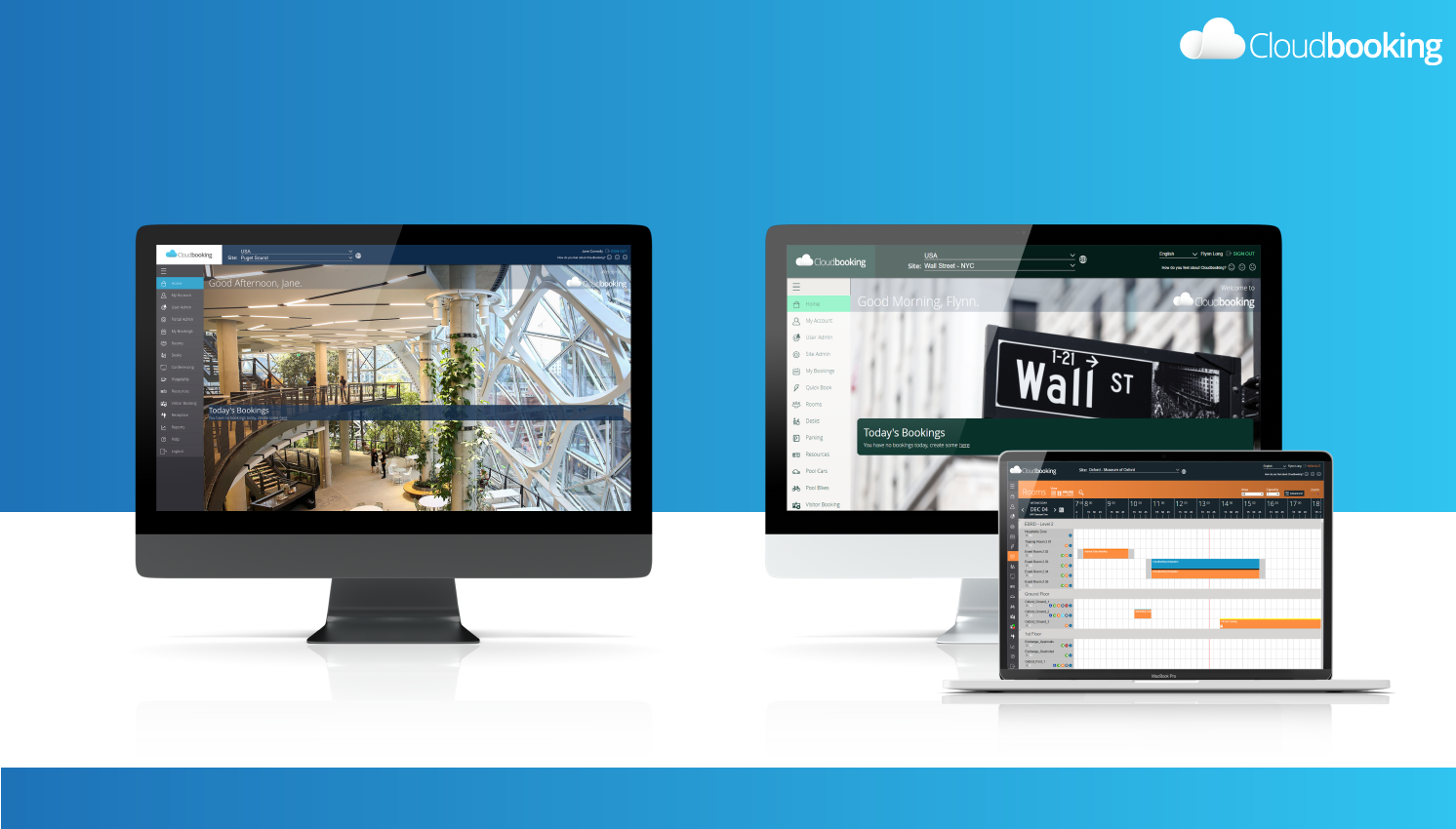
Organizations seeking a post-pandemic return to the office are turning to workspace hoteling to make the workplace safer and more efficient. If you’re looking to reopen your workplace, office hoteling may be the solution for you. We answer FAQs about office hoteling, including how it works and what you need to get started.
The COVID-19 pandemic and the sweeping changes it caused in office management have led to a rising trend of office hoteling: a setup where desks and office spaces are shared between employees — instead of having dedicated users.
There are largely two drivers behind this development.
- Many workers no longer want to be in the office full-time. According to a 2022 study by Ivanti, 71% of employees would choose the ability to work from anywhere over being promoted; 45% didn’t want to return to the office for any reason. This has led to increasing demand for hybrid working arrangements — where employees split their time between remote work and the office.
- Employers want to reduce their office space. In the UK, 37% of organizations are looking to downsize their workplace premises in the aftermath of COVID-19, according to a Rober Walters report.
The success of the global remote work experiment induced by the coronavirus crisis only gives both managers and employees more reason to embrace new ways of working. In fact, research by PwC shows that 83% of employers feel their shift to remote work due to COVID-19 was a success.
PwC Survey Results
Source: PwC
Everything you need to know about office hoteling
If your organization is in the process of reopening the office while simultaneously finding new ways to optimize the use of your facilities, office hoteling may be the solution for you. As an offshoot of activity-based working, office hoteling is one of many approaches to create flexible work setups and address employee requests for remote work.
But what exactly is office hoteling, and how does it work? We go over these and other frequently asked questions below.
1. What is office hoteling?
Office hoteling, also known as desk hoteling, desk booking, and workspace hoteling, is an agile and flexible method of office management in which desks, meeting rooms, conference rooms, and workstations are shared between employees on a dynamic schedule. Think of it as the polar approach to assigning people to permanent workspaces.
As the name suggests, workspace hoteling allows workers to reserve unassigned seating and office spaces on demand — just as you would when booking a room in a hotel. And just like a hotel, any “guest” can use a workstation or office, provided they have a reservation, of course.
This is where workspace hoteling platforms such as desk booking or meeting room booking software come in.
Office hoteling platforms allow workers to book rooms and desks online in advance based on requested characteristics, such as location in the building/floor or size and type of room. In some offices, hoteling options will be determined by specific workplace activities — hence why office hoteling is one approach to activity-based working (more on this later).
Related Reading: Desk Booking Software: Ultimate Guide to Optimizing Your Workplace
2. Where did the concept of office hoteling come from?
While the exact origins of office hoteling are unclear, one of its early proponents was “big four” accounting firm Ernst & Young (EY).
In 1993, the company downsized its Orange County offices to reduce costs, bringing occupancy from four offices down to just one. They then turned to office hoteling to shuffle workers in and out of their smaller premises. Though controversial, the move would allow EY to slash office space costs down by 35% to 40%.
In the 1990s, only a small handful of large companies in the United States had adopted office hoteling. These included the likes of tech giant IBM, business data analysis firm Dun & Bradstreet, and the now-defunct accounting firm Arthur Andersen.
Today, office hoteling still plays an integral role in EY’s flexible working strategy. In 2014, the firm’s Fort Worth offices used hoteling to encourage employees to mingle and build connections with other teams.
3. What are the benefits of office hoteling?
Cost reduction is arguably the biggest factor driving the typical organization to adopt office hoteling.
For example, in 2015, the US Department of Homeland Security (DHS) and the General Services Administration (GSA) identified workspace hoteling as a vital tactic to reduce individual worker occupancy in its headquarters from 230 sq. ft to 155 sq. ft. The move was predicted to increase office occupancy to 18,000 employees and reduce operational costs by $1 billion.
More recently, office hoteling has reemerged as a way to introduce flexibility into the workplace. With more people than ever preferring to work remotely, office hoteling can support hybrid workspaces and ensure workers can effectively schedule their time between telecommuting and in-office work.
Related Reading: A Mini-Guide: How to Adopt Hybrid Working
4. Is hoteling the same as hot desking?
Office hoteling vs hot desking — how are they different?
Office hoteling is often used as an umbrella term for all office and desk sharing methods. But in truth, a hotel-ified office has the specific function of allowing employees to reserve a desk or workspace before or on arrival to the office space.
In contrast, hot desking refers to office setups where multiple workers share a single workspace or station during different periods. How these individual workspaces are shared is ultimately up to the employer. It can be done through:
- A “first come, first served” basis
- Shifting schedules
- A desk and room booking platform.
Related Reading: What Is Hot Desking? The Ultimate Cloudbooking Guide
5. How does office hoteling software work?
Cloudbooking’s Desk Booking Platform
Although different office hoteling platforms have different features, ranging from QR codes to advanced analytics, most of them have the same essential functions:
- They let employers create a virtual floor plan of the office and map individual workstations, surfaces, meeting rooms, conference rooms, and more.
- Employees can book each workspace through an online portal, typically a web page or app.
- Workers indicate how long they intend to use the workspace.
- The office hoteling system blocks out the workspace for the duration of the worker’s schedule, preventing conflicting reservations.
6. What are the pros and cons of office hoteling?
A recent study by Future Forum, a consortium led by Slack Technologies, found that 95% of workers want flexible hours, and 78% want location flexibility. Multiple employers have responded by implementing hybrid working arrangements, both as a way to improve employee morale and reduce office costs.
Related Reading: The Hybrid Workplace, An Employee Census
Office hoteling enables smooth daily operations and ensures the safety and security of your workers. It prevents the number of employees from exceeding the available number of workstations and meeting rooms, allowing them to efficiently plan their days at the office.
However, office hoteling does not come without its criticisms. As EY executives observed in the 90s, office hoteling can reduce employee morale among workers, especially those raised in a culture where having a dedicated, private office was a hallmark of career success.
Related Reading: 10 of the Best London Hot Desk Spots for Remote Workers
7. How does office hoteling support activity-based working?
Activity-based working (ABW) is a human-centric approach to work that gives employees the freedom to choose from multiple work options or settings based on the kind of work they’re doing.
Team Pods at Google’s ABW-Enabled Offices
Source: The New York Times
Open floor plans and shared desks are notable characteristics of activity-based workplaces — the idea being that openness engenders better communication and collaboration. In many offices, the use of office hoteling software ensures that workers aren’t jockeying for space when they arrive at the office. The software also allows managers to monitor occupancy rates and workstation utilization, creating opportunities for improvement.
Find more insights about office hoteling and new ways of working (NWOW) by following the Cloudbooking blog. If you’re looking for a software solution to support office hoteling and activity-based working in your workplace, let Cloudbooking help. Our desk and meeting room booking solutions are packed with features to help managers and employees maximize their use of shared office spaces. Get in touch with our team to schedule an obligation-free demo.




